|
|
|||||||||||
|
|
|||||||||||
 |
|||||||||||
|
|
|||||||||||
|
![]()
|
Guo Weihan - missing link in the history of Xingyiquan found? by Jarek Szymanski |
| Text and photos - Jarek Szymanski; © J.Szymanski 2002 |
| CONTINUATION FROM THE PREVIOUS PAGE : |
| 3.The contents of Guo Weihan's martial art: The style Guo taught to his other disciples was Xinyiquan, the same as the art Dai Longbang taught. Its basics are: |
|
Zhan Dantian of Guo Weihan's lineage is basically the same as the one of Dai Family Xinyiquan | |
| Opening | Contracting | |
|
|
|
|
|
Standing in Tiger Stance is the main standing exercise in Guo Weihan's system |
|
Walking with Chicken Leg develops agile footwork (below) |
|
|
|
|
|
|
||
|
During my stay in Guo Weihan's village I learnt that one of the last Dai clan members from the branch that practiced Xinyiquan lives there. I was amazed to see Dai Guilan, daughter of the late Dai Hongxun (who along with Dai Kui was one of the last Dai clan members actively teaching the art) who is 83 this year, jumped down from the kang (heatable brick bed) to greet me. |
||
|
Below: rare photo of Dai Hongxun, who together with Dai Kui spread the art of Dai Family Xinyi outside Dai clan. Unfortunately the original photo was damaged when we tried to take it from behind the glass which protected it |
Her fitness struck me and I wondered whether she still practiced the art (and was the only Dai clan member to carry it). She denied saying she used to see her father teach so she knew a bit about it but never learnt it herself. Other people from the village said she had never been seen practicing, and although she was often invited to watch local martial arts competition she never performed. During the conversation I had with her she mentioned that her father taught Twelve (Animal) Shapes, although the lineage of Dai Kui, much more popular nowadays, mentions only Ten Big Shapes. It is possible that Dai Hongxun merged some of Small Shapes (Dai Kui's lineage has Seven Small Shapes) with Big Shapes in this way creating the set of twelve. In any case it is difficult to put the final word on who actually increased the number of Shapes into twelve. Hence Cao Jizhi's claim that it was done by Guo Weihan can't be taken for granted. |
Below: Dai Guilan, Dai Hongxun's daughter, in spite of her age is still very healthy and fit. Even if she practiced her family art the high walls around her house would make it impossible for outsiders to know it... |
|
|
|
|
|
|
||
Guo Weihan's system also contains other methods:
|
|
Pi Quan (Splitting Fist) of Guo Weihan's system (Guo WeihangLü HaigengGuo HegFan Jiayuan lineage) perfomed by Mr. Lϋ Hui, Fan Jiayuan's student: |
||
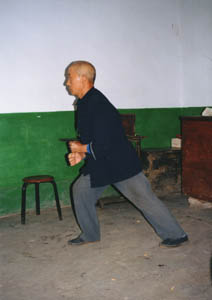 |
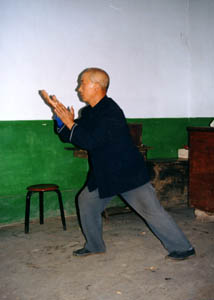 |
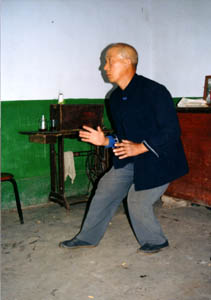 |
| 3 | ˇ 2 | ˇ 1 |
| ¤ | ||
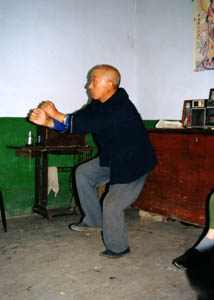 |
Empty hands routines practiced within Guo Weihan's style are:
There are over twenty weapon routines in Guo Weihan's style. They can be generally divided into single routines (practiced by one person) and matched routines (by two and more practitioners). These are all short routines which are performed for less than a minute. The weapons are:
|
|
| 4 | ||
| ¤ | ||
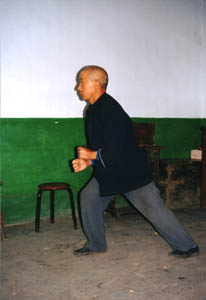 |
||
| 5 | ||
|
The way techniques are practiced differs depending on the season of the year:
All these powers put certain requirements on the practitioners. Hard Power (Gang Jin) requiries Hard Skill (Ying Gong). To develop Hard Skill Xinyiquan practitioners of Guo Weihan lineage practice standing upside down on their hands. Those who already have some skill use only three fingers of each hand to support the body. In more advanced version of this exercise one has to walk on hands while upside down - this is called "Scorpio Covers Its Tail" (Xiezi Yan Wei). It is said the Guo He when 70 was able to walk like this over a distance of 700 meters. This skill however has to be learnt at young age, before one gets married (Tong Zi Gong) |
|
Light Power (Qing Jin) requiries very good flexibility of the body, especially legs and waist. It is said that "one is like a blind demon if one practices martial arts without stretching". Those who wanted to learn Guo Weihan's Xinyiquan had first to acquire basic skills and good flexibility was indispensary. Young kids would start from jumping and stretching for the first years of their martial arts study. It also gave their teacher an opportunity to see whether the student really deserves to learn the advanced art of Xinyiquan. Only once he decided they qualified for further study they would learn Zhan Dantian (Squatting Monkey). Mr. Lü Hui started his practice at the age of 11/12 from basic exercises, including stretching, jumping, general conditioning. At the age of 40 he was still able to touch his chest with the tips of his toes - even today, at the age of 58 he can still touch his chin (Pic. on the right). He can still stand upside down supporting himself with three fingers of each hand as well as perform "Scorpio Covers Its Tail" over a distance of several meters. His gongfu brothers also said that he was able to jump with a somersault over three big (one meter in diameter) water vats. |
Mr. Lü Hui, 58, can still touch foot with his chin. Flexibility is very important part of Guo Weihan's Xinyi basic training |
|
|
| The table below compares three styles - Dai Family Xinyiquan, Guo Weihan's Xinyiquan and Xingyiquan. It is obvious that Guo Weihan's system is more closely related to Dai Family Xinyi than to Xingyiquan. Its main differences with Xingyiquan are in the way the body is used - it is trained through Squatting Monkey, not San Ti, hence Shu-Zhan (Contracting-Opening) are its main features. At the same time it is Bow Stance based - a stance which allows for more complete turn of Dantian than San Ti and full use of rear leg's pushing power (Deng Jin), which is considered a key element required in issuing power in all Xinyi and Xingyi systems. On the other hand Guo's Xinyiquan includes routines which share same names as those of Xingyi system. The basic material of the system is very similar as well - Five Elements and Twelve (Animal) Shapes. However it has to be pointed out that not only Five Elements fists but also the Animals in both styles are performed differently. Another thing is that there are differences within Guo's system. While Pi Quan (as the drawings and photos above show) is very similar, the Animals are not exactly the same - Jia Dajun's system includes Crane (He) and Cat (Mao), while Fan Jiayuan's (coming from Guo through Lü Haigen and Guo He) has Tuo insect and Bear (Xiong) instead. |
|
A brief comparison of Guo Weihan's system, Dai Family Xinyiquan and Xingyiquan: |
|||
| Dai Family Xinyiquan | Guo Weihan's system | Xingyiquan | |
| Basic Internal Methods: | Squatting Monkey (in movement) | Zhan Dantian (in movement), Standing in Tiger Stance (still), Six Harmonies Posture (still) | San Ti Standing (still) |
| Basic Body Method | Contracting and Opening | Contracting and Opening | Qi-Zuan-Luo-Fan Rising-Drilling-Descending-Overturning |
| Basic Stance | Bow Stance (front weighted) | Bow Stance (front weighted) | San Ti (usually back-weighted with weight distribution of 3-7, 4-6 or 5-5) |
| Basic Techniques | Five Elements | Five Elements | Five Elements |
| (Animal) Shapes | Ten Big Shapes + Seven Small
Shapes (Dai Kui) Twelve Shapes (Dai Hongxun) |
Twelve Shapes | Twelve Shapes |
| Main Single Routines | Si Ba (Four Seizes), Four Routines of Za Shi Chui (Breaking Postures Fists), | Four Seizes (Si Ba), Five Routines of Breaking Postures Fists (Za Shi Chui), Twelve Linked Fists (Shi Er Lian Chui), Excellent Kicks Linked Fists (Jing Tui Lianhuan Quan) | Advancing and Retreating Five Elements Linked Fists (Jin Tui Wuxing Lianhuan Quan), Mixed Form Strikes (Za Shi Chui) |
| Main Weapons | Short Stick | Short Stick | Spear |
|
As it appears one would hardly call Guo Weihan's system a missing link between Dai Family Xinyi and Xingyiquan. Not only because of general technical characteristics, but also because of uncertain transmission (as indicated in the beginning of this article). However during the conversation with Guo Weihan's Xinyiquan practitioners another interesting information came out. I was told that that Guo Weihan also practiced Tongbeiquan of He Family, style which was also referred to as "Ape" (Yuanhou) Tongbeiquan. This fact was not only mentioned by the practitioners of Guo Weihan's style, but also other people I met in his home village. It is quite interesting that the latter did not seem to be aware of the fact that Guo also practiced Xinyiquan. It is possible that the secret of transformation from Dai Family Xinyiquan into Li Laoneng's Xingyiquan was through He Family Tongbeiquan. Detailed analysis of Xingyiquan movements and powers not only shows many similarities with its "mother art" of Dai Family Xinyiquan, but also between Xingyiquan and northern long fist styles like Tongbeiquan. On the other hand we do not really know how Dai Family Xinyiquan looked like in the days of Li Laoneng... On the other hand the book "Famous People and Famous Styles of Shanxi Wushu" compiled by Zhang Xigui and Guan Bin mentions Li Gong of Pingyao in Shanxi Province who excelled in Tongbeiquan. In 1920 Li Gong passed the art to Guo He of Qi County. As we already know Guo He was also a Xinyiquan student of Lü Haigen. This would suggest that the combination of Xinyi and Tongbei took place decades after Guo Weihan. This is another question that remains unanswered... The main idea for this article was to introduce Guo Weihan's style for the question who Li Laoneng's teacher was and why Xingyiquan differs so much from Dai Family Xinyi requires more thorough research on the history of both styles and martial arts in general as well as comparative studies of theory, training methods and techniques of the styles. While attempting to explain the relation between Shanxi Xinyi (Guo Weihan's and of Dai clan) and Xingyiquan new questions were raised. I sincerely hope the information in this article will help other researchers to find answers to these questions. In August 2001 I visited Shanxi again to watch International Xingyiquan Competition in Pingyao. It was there where I was given a thin brochure written by one of Guo Weihan's Xinyi practitioners. The brochure introduced history, development and technical contents of the style. However brief look at the contents of the brochure makes the reader realize that at least a part of the material presented there has simply been made out and is not reliable. It is not a pleasant feeling to witness an attempt to create history, but such materials are common traps that everybody who digs in the history of martial arts in China often comes against. End of "Guo Weihan - missing link in the history of Xingyiquan found?"; text and photos © J.Szymanski 2002 |
Home ▪ About me ▪ Updates ▪ Taiji ▪ Bagua ▪ Xinyi-Xingyi ▪ Other Styles ▪ News ▪ Store ▪ Community ▪ Email